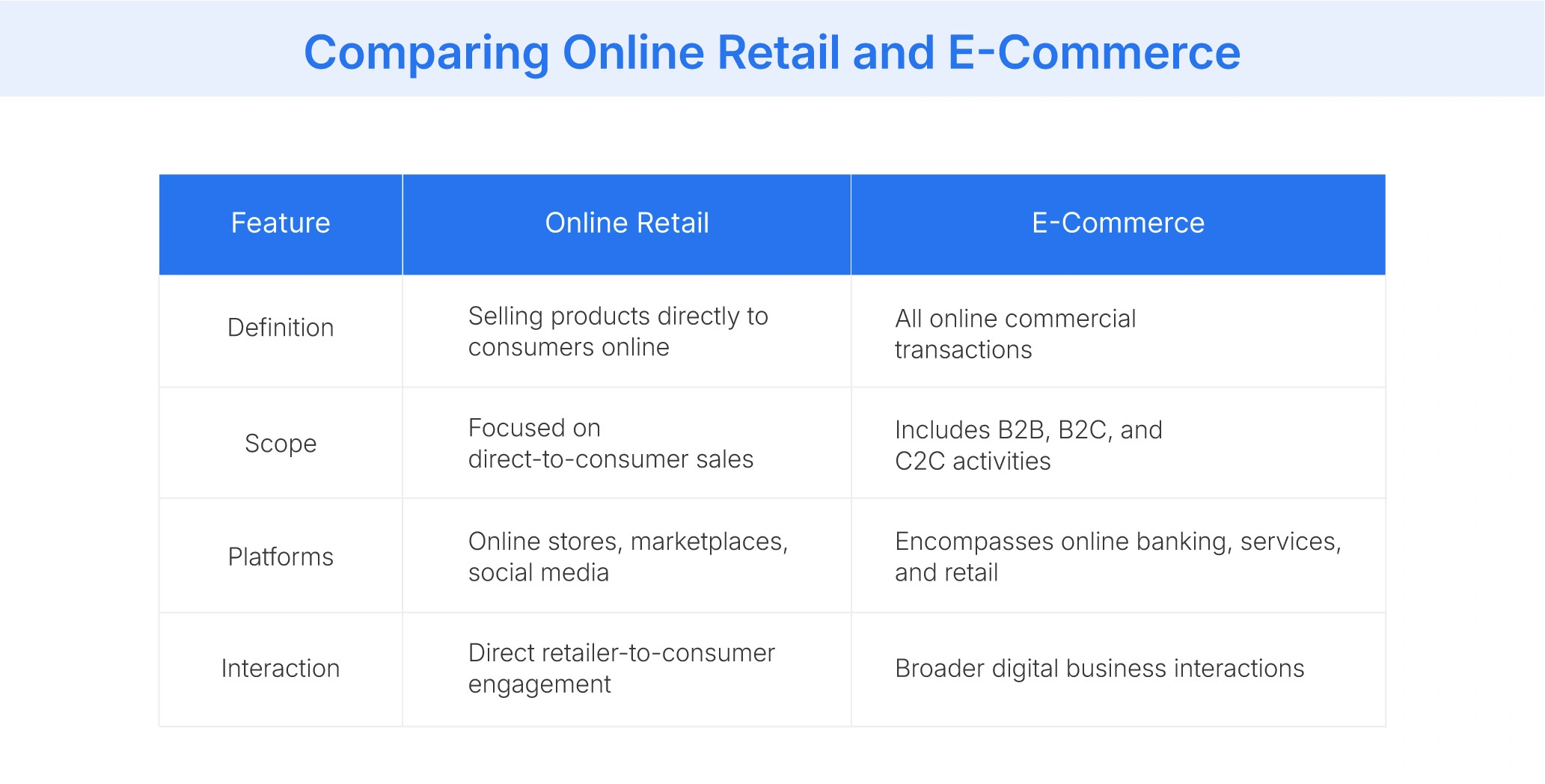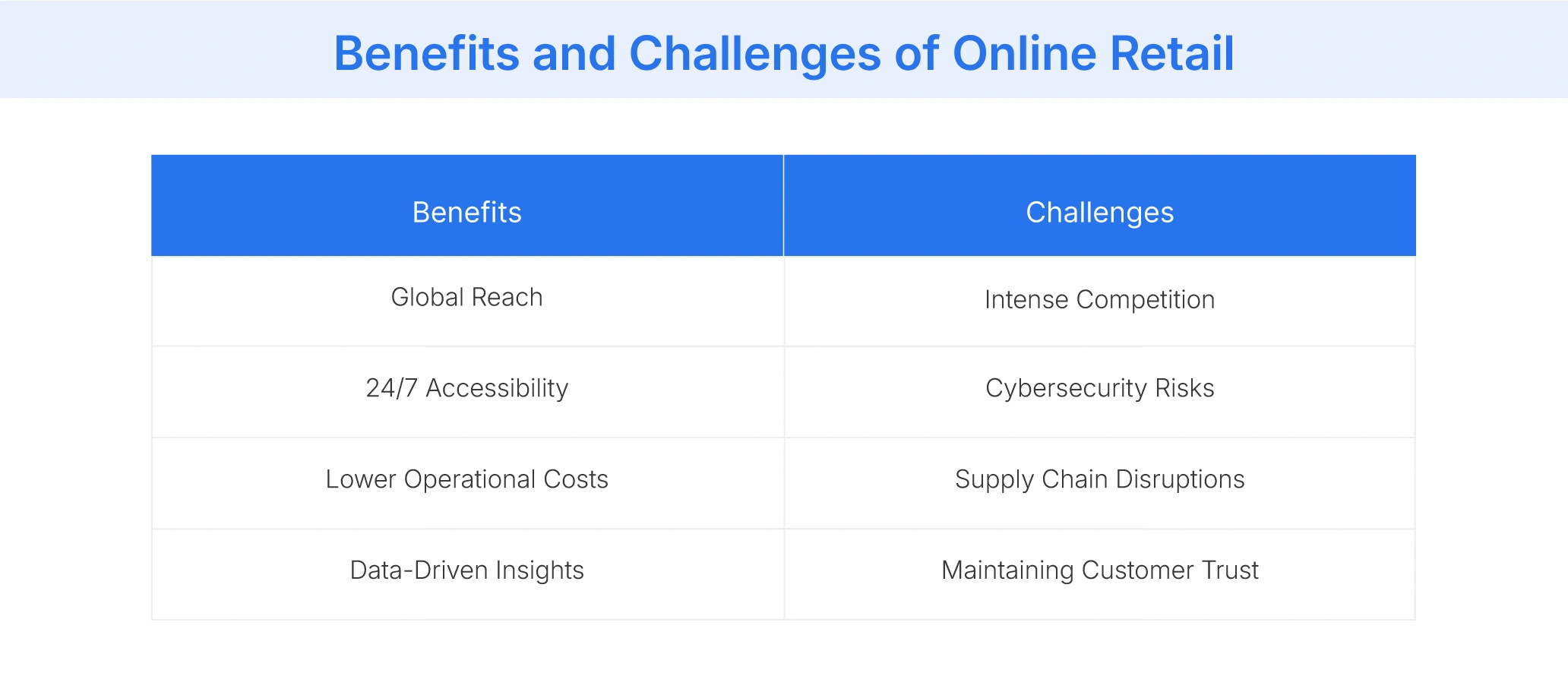Table of Contents
- What is Online Retail?
- Online Retail vs. E-Commerce
- How Online Retail Works?
- Key Benefits of Online Retail
- Challenges of Online Retail
- Popular Online Retail Business Models
- Tools and Technologies for Online Retail Success
- Conclusion
What is Online Retail?
Online retail refers to selling products and services through digital mediums such as e-commerce platforms, online marketplaces, and social media channels. It allows businesses to showcase their offerings, accept payments, and manage transactions entirely over the Internet.
This mode of electronic commerce enables businesses to reach a global customer base, operate continuously, and leverage data-driven strategies to enhance user experience for existing as well as new customers. Unlike traditional retail, which requires a physical presence, online retail eliminates geographical limitations. This makes it easier for online businesses to scale operations and increase profitability through digital storefronts and new technologies.
Online Retail vs. E-Commerce
Online retail refers to selling products directly to consumers through digital platforms, while ecommerce encompasses all online transactions, including B2B, B2C, and C2C models. Online retail is a subset of e-commerce, focusing exclusively on delivering goods and services to individual buyers.
E-commerce includes a broader spectrum, such as online banking, ticket booking, and wholesale transactions. Thus, online retail is a specialized branch of consumer sales. Retailers leverage online retail for direct consumer interaction, while e-commerce covers diverse digital commercial activities.

How Online Retail Works?
Online retail operates through a series of interconnected processes supported by the following three core components:
Online Storefronts and Marketplaces
Online retail businesses can choose between independent e-commerce platforms or third-party marketplaces. Online shopping platforms like Shopify and WooCommerce allow you to create a dedicated online store, giving you full control over branding, design, and customer experience. These ecommerce platforms are ideal for building a unique brand identity but require effort to drive traffic to your online shop. On the other hand, marketplaces like Flipkart or eBay provide access to a large customer base with minimal setup effort. Choosing between these options depends on your business goals and resources.
Order Processing and Payment Systems
Order processing begins when a customer places an order with an ecommerce business. Shopping cart software collects selected items while calculating the total cost, including taxes and shipping fees. Secure payment processing platforms like PayPal or Stripe handle transactions by encrypting payment details, verifying funds, and authorizing payments. Fraud prevention measures are vital to ensure a smooth online shopping experience for both retailers and customers.
Shipping and Fulfillment
Efficient shipping and fulfillment are critical for successful online sales. This involves inventory management to track stock levels, partnerships with reliable shipping carriers like FedEx or DHL, and clear return policies to manage customer satisfaction. The fulfillment process includes picking, packing, labeling, and delivering orders promptly while providing tracking updates to online customers for transparency.
Key Benefits of Online Retail
Here are the key benefits of online retail that help enhance business growth and operational efficiency:
- Global Reach: Online retail enables businesses to reach international locations. This helps expand customer bases and driving sales without the need for physical stores, thus increasing brand visibility.
- 24/7 Accessibility: With online platforms operating continuously, customers can shop anytime, enhancing convenience. This allows businesses to generate revenue beyond standard working hours.
- Lower Operational Costs: Online stores save costs on rent, utilities, and in-store staff. This enables retailers to allocate budgets to marketing, inventory, and customer service improvements.
- Data-Driven Insights: Online retail platforms collect valuable customer data, which helps businesses analyze buying behaviors, optimize inventory, and implement targeted marketing strategies to increase total retail sales and customer satisfaction.

Challenges of Online Retail
Online retail offers significant opportunities, but it also presents several challenges for businesses:
- Intense Competition: The online retail industry is highly competitive, with countless businesses striving to capture customer attention. To stand out in the coming years, companies must focus on unique product offerings, exceptional customer service, and innovative marketing strategies.
- Cybersecurity Risks: Online retail involves handling sensitive customer data, making it a target for cyberattacks. Businesses must implement robust security measures such as encryption, secure payment gateways, and regular system audits to protect the information of online shoppers and maintain trust.
- Supply Chain Disruptions: Global events, supplier issues, or logistical inefficiencies can disrupt supply chains and delay deliveries, leading to dissatisfied customers. Diversifying suppliers and using advanced inventory management systems can help mitigate these risks.
- Maintaining Customer Trust: Establishing trust in an online environment is challenging due to the lack of direct interaction. Transparent policies, reliable customer support, and consistent delivery of promises are essential for building long-term loyalty.
Popular Online Retail Business Models
Online retail operates through various business models, each tailored to different customer and market needs.
Business-to-Consumer (B2C) Online Retail
The B2C model involves businesses selling products or services directly to individual consumers. It is the most common online retail model, in which brands use dedicated e-commerce websites or marketplaces like Walmart to reach their target audience.
B2C platforms often feature user-friendly interfaces, product catalogs, and secure payment gateways to enhance the shopping experience. Examples span from fashion retailers like H&M to electronics stores like Best Buy.
Business-to-Business (B2B) Online Retail
In the B2B model, businesses sell goods or services in bulk to other companies. This model caters to wholesalers, manufacturers, and distributors who require large quantities of products for resale or operational purposes. Platforms like Alibaba facilitate these transactions by offering features such as bulk pricing, custom orders, and negotiated contracts. Compared to B2C, B2B transactions typically involve longer sales cycles and higher order values.
Consumer-to-Consumer (C2C) Online Retail
The C2C model enables individuals to sell products or services directly to other consumers through platforms like eBay, Facebook Marketplace, and OLX. These marketplaces act as intermediaries, providing tools for listing items, facilitating payments, and ensuring secure transactions. C2C platforms are popular for buying and selling second-hand goods or unique items at competitive prices.
Tools and Technologies for Online Retail Success
Achieving success in online retail hinges on the effective use of key tools and technologies:
- E-commerce platforms serve as the foundation, enabling you to showcase products and manage transactions efficiently.
- Customer Relationship Management (CRM) software is vital for nurturing customer relationships, tracking interactions, and enhancing satisfaction.
- AI-driven recommendation engines analyze customer behavior to offer personalized product suggestions, boosting engagement and total sales.
- Inventory management solutions provide real-time visibility into stock levels, helping you avoid overstocking or stockouts, which can lead to lost sales.
At Flipkart Commerce Cloud (FCC), we offer a comprehensive suite of solutions tailored for online retailers. Our composable digital commerce solution allows you to build a flexible and scalable online store, adapting to evolving business needs. Our advanced retail media platform enables the creation of a self-serve, cookie-less retail media network with rich ad formats powered by machine learning, driving an impressive 120% return on ad spend (ROAS). Additionally, our pricing tool assists in optimizing pricing strategies, ensuring competitiveness while maintaining profitability.
Conclusion
Online retail has become an indispensable part of modern commerce, offering convenience and global reach. To stay competitive, you must continuously adopt evolving strategies, leveraging advanced technologies and data-driven insights. Embracing innovation helps you enhance customer experiences, streamline operations, and respond to market demands effectively. As consumer expectations grow, staying agile and proactive ensures your online retail business thrives in an ever-changing digital landscape.
FAQ
Successful online retail businesses include Target, Etsy, and Walmart. These companies dominate the market by leveraging technology, personalized customer experiences, and efficient logistics. Their success highlights the importance of innovation, scalability, and customer-centric strategies in building thriving online retail ventures and capturing higher market share.
Online retail handles returns by providing clear policies, return labels, and automated systems for tracking requests. After quality checks, refunds are processed through the original payment methods, ensuring customer satisfaction. Efficient return management enhances trust and loyalty, which are crucial for sustaining online retail success.
You can start an online retail store by selecting a suitable e-commerce platform, sourcing products, setting up secure payment methods, and creating a user-friendly website. Implementing digital marketing strategies helps attract customers, while efficient logistics and customer service ensure seamless operations and long-term growth.

